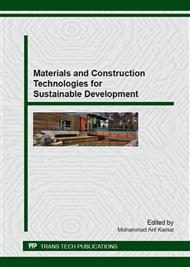[1]
T. Wiedmann: Editorial Carbon Footprint and Input-Output Analysis – An introduction. Economic Systems Research (2014).
Google Scholar
[2]
Directive 2002/91/EC Energy Performance of Buildings, Information on http: /eur-lex. europa. eu/LexUriServ/LexUriServ. do?uri=OJ: L: 2003: 001: 0065: 0065: EN: PDF. 04/04/(2014).
Google Scholar
[3]
European Regulation 305/2011 Construction Products Regulation, Information on http: /eur-lex. europa. eu/LexUriServ/LexUriServ. do?uri=OJ: L: 2011: 088: 0005: 0043: EN: PDF. 04/04/(2014).
Google Scholar
[4]
European Regulation 89/106 Construction Products Regulation, Information on http: /eur-lex. europa. eu/LexUriServ/LexUriServ. do?uri=OJ: L: 1989: 040: 0012: 0026: EN: PDF. 06/04/(2014).
Google Scholar
[5]
Information on http: /www. ghgprotocol. org/calculation-tools. 06/04/(2014).
Google Scholar
[6]
ISO-International Organization for Standarization, 2006. ISO 14064-1: 2006. Greenhouse gases – Part 1: Specification with Guidance at the Organization Level for Quantification and Reporting of Greenhouse Gas Emissions and Removals.
DOI: 10.3403/30094283u
Google Scholar
[7]
Information on http: /www. ipcc-nggip. iges. or. jp/public/2006gol/index. html.
Google Scholar
[8]
Information on http: /www. ipcc-nggip. iges. or. jp/EFDB/main. php.
Google Scholar
[9]
Anderson, J., Shiers, D., & Sinclair, M. (2002). The green guide to specification (3rd ed. ). Oxford: Building Research Establishment (BRE), Oxford Brookes University.
Google Scholar
[10]
Y.S. Lee, D.A. Guerin: Indoor environmental quality differences between office types in LEED certified buildings in the US. Building and Environment, 45(5) (2010), 1104–1112.
DOI: 10.1016/j.buildenv.2009.10.019
Google Scholar
[11]
E. Giama and A.M. Papadopoulos A.M., 2012: Sustainable Building Management: An overview of Certification Schemes and Standards, Advances in Building Energy Research, (2012) DOI: 10. 1080/17512549. 2012. 740905.
DOI: 10.1080/17512549.2012.740905
Google Scholar
[12]
L.F. Cabeza, L. Rincon, V. Vilarino, G. Perez and A. Castell: Life Cycle assessment (LCA) and life cycle energy analysis (LCEA) of buildings and the building sector: A review. Renewable and Sustainable Energy Reviews, (29) (2014) 394-416.
DOI: 10.1016/j.rser.2013.08.037
Google Scholar
[13]
I.Z. Bribian, A.V. Capilla, A. A Uson: Life cycle assessment of building materials: Comparative analysis of energy and environmental impacts and evaluation of the eco-efficiency improvement potential, Building and Environment, 46 (2011).
DOI: 10.1016/j.buildenv.2010.12.002
Google Scholar
[14]
Information on http: /www. lagie. gr/en/market/market-analysis/das-monthly-reports/. Greece. 12/04/(2014).
Google Scholar
[15]
EUROSTAT Sustainable development - consumption and production. Information on http: /epp. eurostat. ec. europa. eu/tgm/table. do?tab=table&init=1&plugin=1&language=en&pcode=tsdcc330. 05/04/(2014).
Google Scholar
[16]
Pré Consultants: The Eco Indicator 99: A damage oriented method for Life Cycle Impact Assessment. Manual for designers, Third Edition. www. pre. nl. Switzerland (2001).
Google Scholar
[17]
Pré Consultants: SimaPro LCA software, Version 7. 1., Product écology Consultants, Netherlands. www. pre. nl/simapro. Switzerland (2009).
Google Scholar
[18]
CML 2 baseline method 2000. Centre for Environmental Studies (CML), University of Leiden, Information on : http: /www. leidenuniv. nl/interfac/cml/ssp/LCA2/index. html.
Google Scholar
[19]
Pré Consultants: The Eco Indicator 95, manual for designers (1996). Switzerland.
Google Scholar
[20]
D. A Anastaselos, S. Oxizidis, Papadopoulos A.M.: Energy, environmental and economic optimization of thermal insulation solutions by means of an integrated decision support system, Energy and Buildings 43 (2011), 686–694.
DOI: 10.1016/j.enbuild.2010.11.013
Google Scholar
[21]
E. Giama, A.M. Papadopoulos: Assessment tools for the environmental evaluation of concrete, plaster and brick elements production, Journal of Cleaner Production 1-11, (2015) DOI: 10. 1016/j. jclepro. 2015. 03. 006.
DOI: 10.1016/j.jclepro.2015.03.006
Google Scholar


